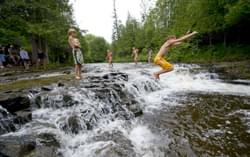




Ocqueoc Falls Bicentennial Pathway leads visitors to the only publicly owned waterfall in Michigan's Lower Peninsula.
by Michigan Department of Natural Resources, Parks and Recreation Division

Ocqueoc Falls Bicentennial Pathway leads visitors to the only publicly owned waterfall in Michigan's Lower Peninsula. Access to the falls, however, was limited to visitors who were able to scramble across the uneven, wooded landscape and then descend the 14-foot high rocky incline to the river’s edge. Individuals with physical limitations or families with young children were often not up to these challenges.
The Michigan Parks and Recreation Division worked with the Accessibility Advisory Council of the Department of Natural Resources to make the falls area available to people of all abilities. With grants from the Recreational Trails Program, the Michigan Natural Resource Trust Fund, and the Recreation Improvement Fund, renovation work was planned with the goal of making the falls accessible.
When designers saw how people were “climbing down” to Ocqueoc Falls, they saw an opportunity to use Universal Design principles while connecting people with nature in a challenging, fun and memorable way. In addition to the accessible ramp paralleling the wooded embankment, a tiered climbing wall with strategically placed transfer stations allows anyone of any age to enjoy this new challenge. Now visitors have multiple means of navigating the bluff. The result is that Ocqueoc Falls is the first truly universally accessible waterfall in the nation.
The paved trail from the parking lot to the waterfall area was widened to comfortably allow groups of travelers— including people who use wheelchairs or other mobility devices— to pass through. Two picnic areas were surfaced with compacted crushed limestone and outfitted with accessible-designed picnic tables. And the benches along the pathway are complete with accessible clear space, which are cement pads next to them, to allow for side-by-side seating of a person using a wheelchair and someone who is not.
A recycled-plastic, decked ramp provides the easiest route to the river. At the end of the ramp is a transfer station— a series of tiered flat rocks that allow someone to transfer from a wheelchair, down the rocks, to the water's edge and into the water. Along the path is a platform to allow for viewing of the falls.
New accessible picnic areas are located within the woods and along the bluff, offering guests a variety of scenic picnicking options. The picnic areas were surfaced with compacted crushed limestone and outfitted with accessible- designed picnic tables.
The redesigned parking lot improves traffic flow and provides parking for recreation vehicles and vehicles pulling trailers. The lot accommodates approximately 50 vehicles and has barrier-free spaces for both cars and cars with trailers. An accessible path leads guests from the parking lot to the campground and includes road crossing identification for motorists and pedestrians.
The Ocqueoc Falls Bicentennial Pathway was recognized by the National Multiple Sclerosis Society in 2013 and received the da Vinci Award, under the “environmental adaption for working and daily living” category, by providing assistive and adaptive technologies.
According to the Department of Natural Resources, “Ocqueoc Falls is now a place where children (and adults) can ex- perience the joy of nature on an intimate level, where all their senses are engaged through sight, sound, touch, and smell. It is a place where the imagination is freed, where castles can be climbed, or rivers forded to reach foreign shores. It is an area where young and old can explore together.”
With its accompanying state forest campground and Ocqueoc Falls Bicentennial Pathway (www.michigan.gov/ocqueocfalls) — consisting of four loops of scenic trails ranging from 2.85 miles to 6 miles long, perfect for hiking and biking— Ocqueoc Falls is becoming a popular vacation destination.
For more information about Ocqueoc Falls’ development, view the video “Ocqueoc Falls: Welcoming waters with universal appeal” at http://bit.ly/1gKc4Bq
For more information on Michigan's trail system, visit www.michigantrailmaps.com
Accessibility Toolkit for Land Managers
posted Feb 24, 2024
Accessibility means more than ADA. What makes you feel welcome in outdoor spaces? When you visit a new park, how do you know that people want you to be there, that you belong?
The Trail Access Project Removes Barriers to the Outdoors
posted Feb 11, 2022
Their goal is to facilitate the removal of barriers to recreational trail usage through providing information, increasing accessible features, and supporting park managers in making changes.
Accessibility in the National Park Service
posted Feb 5, 2020
While notable advancements have been made, much is needed to break down the barriers and embrace greater inclusivity. Parks, programs, and leaders across the service need more education, guidance, support, and resources to create more welcoming experiences for a broad spectrum of audiences.
posted Feb 5, 2020
The purpose of the study was to identify the perceptions of people with disabilities relative to program and physical accessibility in the National Park Service.
3,555 views • posted 04/02/2018